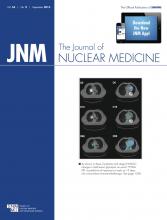TO THE EDITOR: The recent work by Ulrich et al. (1) discussed the value of intratumoral 99mTc-macroaggregated albumin (MAA) distribution to predict treatment outcome after 90Y-radioembolization in patients with colorectal cancer liver metastasis. Their results demonstrated that response was independent of the degree of intratumoral 99mTc-MAA uptake. This is an important and interesting finding, but it should be interpreted with caution. Several studies have shown that pretherapeutic dosimetric calculations based on 99mTc-MAA distribution may lead to improved treatment planning methods based on tumor dosimetry (2,3). Because these developments are expected to lead to a paradigm shift in radioembolization treatment planning, from empiric methods to individualized treatment planning, it is critical that we carefully evaluate all aspects of scout dose imaging for radioembolization treatment planning. It is imperative to emphasize the importance of optimized scout dose imaging. Some additional comments may therefore be relevant to their research.
The presented study confirmed previous findings on the questionable prognostic value of pretherapeutic 99mTc-MAA distribution (4). In our series we found a difference in activity distribution between 99mTc-MAA and 90Y of at least 10% in as many as 153 (68%) of 225 segments in 39 procedures (5). However, instead of correlating 99mTc-MAA distribution to posttherapeutic 90Y distribution, the presented study correlated pretherapeutic 99mTc-MAA directly with parameters of efficacy. This methodology lacks an important stepwise approach.
First, the predictive value of pretherapeutic 99mTc-MAA should be evaluated to predict posttherapeutic 90Y distribution, and subsequently, posttherapeutic 90Y distribution should be compared with treatment outcome, both quantitatively. Otherwise, 90Y distribution poses a significant confounding factor. Technical aspects of radioembolization are especially important for step 1, whereas clinical and biologic aspects of dose–response will influence step 2. Distribution differences between 99mTc-MAA and 90Y are influenced by catheter tip position differences during the administration of both agents. This should be looked at in detail. Very small subcentimeter differences, as well as positioning the tip close to major bifurcations and side branches, may cause substantial differences in distribution (4,5). But also the in-plane cross-sectional position of the catheter tip causes distribution variations (6). Close attention to catheter tip positioning, possibly augmented by special catheters designed to fix the centriluminal positioning of the tip (7), will likely improve the predictive value of 99mTc-MAA scout dose imaging. Besides, an agent that better resembles the treatment device may replace 99mTc-MAA. For this purpose our group recently introduced new-generation microspheres for hepatic radioembolization: 166Ho microspheres (8). These microspheres offer accurate pre- and posttherapeutic quantitative imaging by SPECT (81 keV) and MR imaging (paramagnetic properties) but also offer effective treatment by β-radiation (half-life, 27 h; 1.8 MeV).
Second, dose–response relationships have not been established yet. The previously mentioned publications on partition modeling were among the first to show such effects, but these studies were limited to hepatocellular carcinoma only. Interestingly, it was shown that the pattern of activity uptake around the tumor influenced the response to radioembolization (3). This was caused by variations in tumor perfusion, depending on location, and should be accounted for during treatment planning. Establishing such methods for multiple lesions in both liver lobes, such as colorectal cancer liver metastasis, is a great challenge because each tumor needs to be evaluated separately. The reported response in this cell type is very low (in the presented study only 10.4% at 3 mo). It is not yet clear whether this is caused by resistance to radiation or by underdosing, but proper dosimetry should further elucidate these issues. Nevertheless, it is expected that individualized treatment planning based on pretherapeutic dosimetry will ultimately lead to improved efficacy and toxicity. Because the response in the presented study was too little to reveal any relation with activity distribution, the authors used a nonvalidated response parameter (i.e., size change). It is also important that we stick to validated endpoints, including survival, for future investigation (9).
Negative results should not lead to cessation of our quest for optimized dosimetry, since these results do not necessarily imply that no relation exists. They merely, but importantly, tell us that we should overcome the limitations that lead to these negative findings, in order to establish validated methods for individualized pretherapeutic treatment planning.
Footnotes
Published online Jun. 18, 2013.
- © 2013 by the Society of Nuclear Medicine and Molecular Imaging, Inc.







